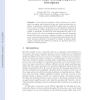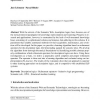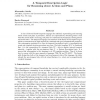503 search results - page 22 / 101 » Combining Description Logics, Description Graphs, and Rules |
SEMWEB
2007
Springer
14 years 1 months ago
2007
Springer
Classical ontologies are not suitable to represent imprecise nor uncertain pieces of information. As a solution we will combine fuzzy Description Logics with a possibilistic layer....
ACIVS
2009
Springer
14 years 2 months ago
2009
Springer
Abstract. In the pattern recognition context, objects can be represented as graphs with attributed nodes and edges involving their relations. Consequently, matching attributed grap...
ML
2010
ACM
13 years 2 months ago
2010
ACM
With the advent of the Semantic Web, description logics have become one of the most prominent paradigms for knowledge representation and reasoning. Progress in research and applica...
JAIR
1998
13 years 7 months ago
1998
A class of interval-based temporal languages for uniformly representing and reasoning about actions and plans is presented. Actions are represented by describing what is true whil...
ECAI
2010
Springer
13 years 5 months ago
2010
Springer
Bipolarity is an important feature of spatial information, involved in the expression of preferences and constraints about spatial positioning or in pairs of opposite spatial relat...



